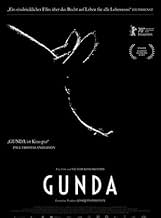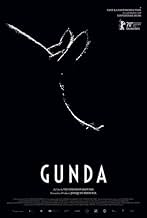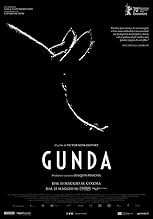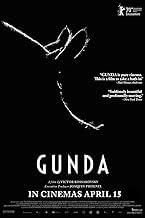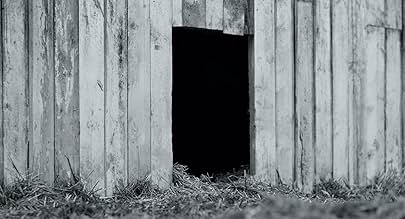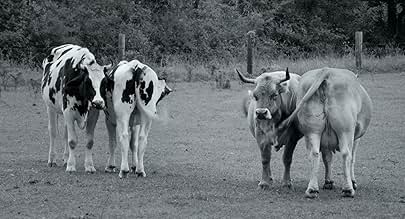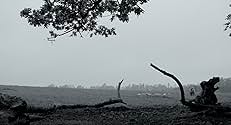AVALIAÇÃO DA IMDb
7,1/10
3,1 mil
SUA AVALIAÇÃO
Relata a vida diária de um porco e seus companheiros de fazenda: duas vacas e uma galinha de uma perna.Relata a vida diária de um porco e seus companheiros de fazenda: duas vacas e uma galinha de uma perna.Relata a vida diária de um porco e seus companheiros de fazenda: duas vacas e uma galinha de uma perna.
- Direção
- Roteiristas
- Artista
- Prêmios
- 9 vitórias e 32 indicações no total
- Direção
- Roteiristas
- Elenco e equipe completos
- Produção, bilheteria e muito mais no IMDbPro
Avaliações em destaque
A stunning black and white silent (save the grunting) documentary that soft focuses on the life of a pig. Seems innocuous enough, but there is magic here. Shot at ground level, and sparing nothing from farm life, "Gunda" is not here to shock, or illicit clown tears, but to have a look, like a wide-eyed child might back in the day when summers were not filled with organized sports camps or school continuation. It captures that slow, languid, breezy feel of beautiful boredom.
Opening with the birth of a litter, it follows the towering mother sow as she clumsily deals with the runt of her offspring. It is astonishing, inviting, and then shockingly cruel. What is happening is not exactly clear, and there is no deep voice over to mansplain nature. That is the beauty of this film: it evolves along with the undetermined storyline.
A slow, dreamy bit of cinema, "Gunda" works well in transporting the audience to a world most are familiar with but few actually know or have experienced hands on. The sharp monochrome delivery turns a pigsty into a pleasant aesthetic. The absence of smell helps. Nothing revelatory here, and since this is a farm, well, let's just say that the animals are not in charge, and there is a sudden dramatic turn to remind everyone about life's cold harsh realities.
"Gunda" is an animal film that is really not an animal film. It is a brilliant exercise in moment capture, shot with an addictive lens, documenting some life lessons, without preaching or dwelling on anything in particular. Pigs in showbiz are usually funny, smart or exotic. Not here. "Gunda" is a mother, and that is that.
Opening with the birth of a litter, it follows the towering mother sow as she clumsily deals with the runt of her offspring. It is astonishing, inviting, and then shockingly cruel. What is happening is not exactly clear, and there is no deep voice over to mansplain nature. That is the beauty of this film: it evolves along with the undetermined storyline.
A slow, dreamy bit of cinema, "Gunda" works well in transporting the audience to a world most are familiar with but few actually know or have experienced hands on. The sharp monochrome delivery turns a pigsty into a pleasant aesthetic. The absence of smell helps. Nothing revelatory here, and since this is a farm, well, let's just say that the animals are not in charge, and there is a sudden dramatic turn to remind everyone about life's cold harsh realities.
"Gunda" is an animal film that is really not an animal film. It is a brilliant exercise in moment capture, shot with an addictive lens, documenting some life lessons, without preaching or dwelling on anything in particular. Pigs in showbiz are usually funny, smart or exotic. Not here. "Gunda" is a mother, and that is that.
- hipCRANK.
Greetings again from the darkness. We open on a pig in prone position with her head sticking through an opening in the barn. It takes a minute to realize the sow isn't sleeping, but rather giving birth. Slowly the newborn piglets begin tumbling out into the world. Cutting to a reverse camera angle, we see the 12-13 babies desperately trying to latch onto mom for their first meal. The runt of the litter struggles more than the others. Award-winning filmmaker Viktor Kosakovskiy runs this first segment just over 19 minutes. There is no dialogue. No human on screen. The soundtrack is all natural from nature: the snorts from mama sow, the squeals from piglets, and unseen birds chirping.
Our second segment finds roosters in a crate. Clearly new to the surroundings, and likely never-before "free" to roam the land, these chickens cautiously explore as the camera focuses on their tentative initial steps from the cage and startled reactions to birds. A one-legged rooster captures our attention as it makes its way through the grass and over fallen logs. It's likely the longest amount of time a movie camera has been dedicated to following roosters around.
We then head back to find the piglets have grown substantially. We don't know how much time has passed, but we watch along with their mother as the youngsters play in the field, fight with each other, and bully their youngest sibling. Gunda, the mother sow, watches over them just as any mother would watch over her kids. Our third group is introduced as the barn door opens and the cows are released. They romp into the fields like school kids at recess. Some of the cows stare directly into the camera as if to inform us they are ready for their close-up. It's fascinating to see how they use teamwork for an ingenious head-to-tail solution to the annoying flies that relentlessly pester them.
The final segment returns us to the pigs as they display the same feeding frenzy as one might witness at the buffet on a Carnival cruise. An ending that will surely evoke emotions in viewers, though maybe not at the extreme of Gunda herself. Filmmaker Kosakovskiy leaves us wondering how a black and white film with no dialogue or human characters makes such an impression as it focuses on farm animals. Pork, chicken, and beef. Clearly it's no coincidence that he chose three staples of the American diet. There is no lecture on animal rights, and none of the brutality of other "raised for food" documentaries is shown. But the message is there. It was filmed on farms in Norway, Spain, and the U. K., but the locales matter little. Director Kosakovskiy previously brought us the excellent AQUARELA (2018), a documentary showcasing the nature of water and ice, and here he assisted Egil Haskjold Larsen with cinematography, and Ainara Vera with editing. It's an unusual film, and one meant to inspire reflection and thought ... and hopefully change.
In theaters beginning April 16, 2021.
Our second segment finds roosters in a crate. Clearly new to the surroundings, and likely never-before "free" to roam the land, these chickens cautiously explore as the camera focuses on their tentative initial steps from the cage and startled reactions to birds. A one-legged rooster captures our attention as it makes its way through the grass and over fallen logs. It's likely the longest amount of time a movie camera has been dedicated to following roosters around.
We then head back to find the piglets have grown substantially. We don't know how much time has passed, but we watch along with their mother as the youngsters play in the field, fight with each other, and bully their youngest sibling. Gunda, the mother sow, watches over them just as any mother would watch over her kids. Our third group is introduced as the barn door opens and the cows are released. They romp into the fields like school kids at recess. Some of the cows stare directly into the camera as if to inform us they are ready for their close-up. It's fascinating to see how they use teamwork for an ingenious head-to-tail solution to the annoying flies that relentlessly pester them.
The final segment returns us to the pigs as they display the same feeding frenzy as one might witness at the buffet on a Carnival cruise. An ending that will surely evoke emotions in viewers, though maybe not at the extreme of Gunda herself. Filmmaker Kosakovskiy leaves us wondering how a black and white film with no dialogue or human characters makes such an impression as it focuses on farm animals. Pork, chicken, and beef. Clearly it's no coincidence that he chose three staples of the American diet. There is no lecture on animal rights, and none of the brutality of other "raised for food" documentaries is shown. But the message is there. It was filmed on farms in Norway, Spain, and the U. K., but the locales matter little. Director Kosakovskiy previously brought us the excellent AQUARELA (2018), a documentary showcasing the nature of water and ice, and here he assisted Egil Haskjold Larsen with cinematography, and Ainara Vera with editing. It's an unusual film, and one meant to inspire reflection and thought ... and hopefully change.
In theaters beginning April 16, 2021.
For a subject not often given an artistic treatment, barnyard animals, Gunda is exquisitely shot. In a loving way, it shows that pigs, cows, and chickens have emotions, that they enjoy being alive, and that they have dignity. I loved it for that, and if just looking at animals go about their lives on a farm is appealing to you, this is probably your film, but otherwise, you might find its 93 minutes passing rather slowly.
There is clearly an underlying message here, but I loved how restrained the film was in getting this across. It was filmed at humane farms and sanctuaries, without narration of any kind, and that includes holding back from the customary text at the end of documentaries which fill us in on various facts and details. The viewer is left to connect the dots from the images on the screen to what was on their dinner plate most recently, or the neat cuts of packaged meat in the grocery, seen as commodities instead of living creatures. The scene where the mother pig frantically searches for her babies towards the end is distressing, but a far more damning portrayal of the cruelty of the meat industry would have been at a factory farm, and/or a slaughterhouse. In other words, this is just the tip of an enormous, immoral iceberg - and yet if taking babies away from a mother doesn't hit you in the gut, I'm not sure what will.
There is clearly an underlying message here, but I loved how restrained the film was in getting this across. It was filmed at humane farms and sanctuaries, without narration of any kind, and that includes holding back from the customary text at the end of documentaries which fill us in on various facts and details. The viewer is left to connect the dots from the images on the screen to what was on their dinner plate most recently, or the neat cuts of packaged meat in the grocery, seen as commodities instead of living creatures. The scene where the mother pig frantically searches for her babies towards the end is distressing, but a far more damning portrayal of the cruelty of the meat industry would have been at a factory farm, and/or a slaughterhouse. In other words, this is just the tip of an enormous, immoral iceberg - and yet if taking babies away from a mother doesn't hit you in the gut, I'm not sure what will.
This is a superb piece of filmmaking that gives the viewer a real insight in to the lives of pigs and cows on higher welfare farms and of free to roam hens. No one who watches this film could doubt the sentience of its subjects or their individuality. The incredibly devoted mother pig at the centre of this film and a one legged hen are exhibits A and B in this regard. Sound is used to particularly good effect, both in the capture of the farm and country noises and in the complete absence of any commentary. The black and white footage adds to the beauty of the piece but I can't help thinking that the complete absence of colour ultimately detracts a little from an otherwise wholly authentic film. The film may not turn you into a vegetarian or a vegan but for me it surely supports an argument that particularly in the rich developed world all animals should be raised to at least "freedom food" standards and that its an indictment of modern society that some of the richest countries have the poorest animal welfare standards.
IN BRIEF: A well-made but slow moving pig's tale.
JIM'S REVIEW: (RECOMMENDED) A pig and her litter, a one-legged chicken, and some cows are the main cast in this fine documentary, Gunda, Viktor Kosakovskiy's understated cinematic plea for animal rights.
Gunda is an enormous sow that has just given birth to a dozen small piglets. This is their story of life down on the farm. Call me a city boy, but the film depicts the daily mundane weeks in this pig's heaven (or hell) and I have chosen the right lifestyle for me. Still, it is a fascinating place to visit.
There are no voiceovers, no sweeping musical score, no Disney sentimentalizing... just straight-forward filming of natural country events. There are many grunts, squeals, and moos to be heard and lots of mud and flies buzzing around too.
This is a well-made documentary that tries to convey an animal's everyday existence. The wonderful sound design by Alexander Dudarev immerses the moviegoer into this rarely-seen animal kingdom. The masterful b&w photography by Egil Håskjold Larsen and the director is stunning with its low-level point of view and detailed close-ups of farm critters.
However, the story seems non-existent and Mr. Kosakovskiy lets scenes go on for far too long, at a turtle's pace, although none of those creatures are in sight. The documentary does eventually build to its subtle message about the cruelty of our food chain, but any astute moviegoer knows the fate of our little dirty dozen from the start. (A side note: All of our violent deeds are strongly implied, but mercifully not shown.) I could say there is much food for thought in this documentary, but then I would be called insensitive or callous. Let's just say, this film deserves your attention. (GRADE: B-)
JIM'S REVIEW: (RECOMMENDED) A pig and her litter, a one-legged chicken, and some cows are the main cast in this fine documentary, Gunda, Viktor Kosakovskiy's understated cinematic plea for animal rights.
Gunda is an enormous sow that has just given birth to a dozen small piglets. This is their story of life down on the farm. Call me a city boy, but the film depicts the daily mundane weeks in this pig's heaven (or hell) and I have chosen the right lifestyle for me. Still, it is a fascinating place to visit.
There are no voiceovers, no sweeping musical score, no Disney sentimentalizing... just straight-forward filming of natural country events. There are many grunts, squeals, and moos to be heard and lots of mud and flies buzzing around too.
This is a well-made documentary that tries to convey an animal's everyday existence. The wonderful sound design by Alexander Dudarev immerses the moviegoer into this rarely-seen animal kingdom. The masterful b&w photography by Egil Håskjold Larsen and the director is stunning with its low-level point of view and detailed close-ups of farm critters.
However, the story seems non-existent and Mr. Kosakovskiy lets scenes go on for far too long, at a turtle's pace, although none of those creatures are in sight. The documentary does eventually build to its subtle message about the cruelty of our food chain, but any astute moviegoer knows the fate of our little dirty dozen from the start. (A side note: All of our violent deeds are strongly implied, but mercifully not shown.) I could say there is much food for thought in this documentary, but then I would be called insensitive or callous. Let's just say, this film deserves your attention. (GRADE: B-)
Você sabia?
- CuriosidadesJoaquin Phoenix and Paul Thomas Anderson were amongst the first people in the industry to publicly praise the film.
- Erros de gravaçãoGunda is shown wallowing in mud and the mud covers her teats. In the next sequence, her piglets suckle her teats which are suddenly clean.
Principais escolhas
Faça login para avaliar e ver a lista de recomendações personalizadas
Detalhes
- Data de lançamento
- Países de origem
- Centrais de atendimento oficiais
- Idioma
- Também conhecido como
- Gunda: Mother, Pig
- Locações de filme
- Grøstad farm, Undrumsdal in Tønsberg municipality, Noruega(the pig farm location)
- Empresas de produção
- Consulte mais créditos da empresa na IMDbPro
Bilheteria
- Faturamento bruto nos EUA e Canadá
- US$ 115.691
- Fim de semana de estreia nos EUA e Canadá
- US$ 5.023
- 18 de abr. de 2021
- Faturamento bruto mundial
- US$ 383.128
- Tempo de duração1 hora 33 minutos
- Cor
- Proporção
- 1.85 : 1
Contribua para esta página
Sugerir uma alteração ou adicionar conteúdo ausente





